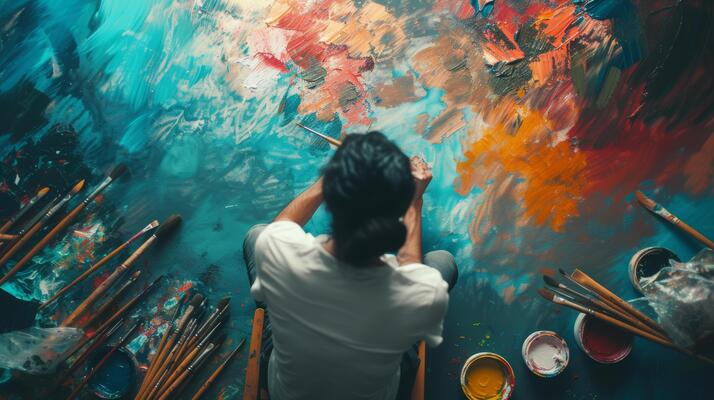Creating Unity Through Photo-Based Painting Techniques
In the world of art and photography, creating unity through photo-based painting is a captivating practice that is gaining momentum among professional photographers. This technique combines the precision of photography with the expressive quality of painting, offering a unique avenue to convey a unified artistic vision. Whether you're a seasoned photographer or an emerging artist, understanding how to create harmony and cohesion in your work through this medium can elevate your craft to new heights.
The idea of creating unity through photo-based painting involves blending photographic elements with traditional painting techniques to form a seamless whole. This approach not only enriches the visual appeal of your work but also allows for deeper storytelling and emotional resonance. As we delve into this fascinating subject, we will explore the various techniques, the importance of composition, and the role of color harmony in achieving artistic unity.

Understanding Photo-Based Painting
At its core, photo-based painting is about transforming a photographic image into a painted masterpiece. This process begins with a photograph, which serves as the foundation for the painting. Artists can choose to replicate the photograph closely or use it as a starting point for creative exploration. The goal is to blend the realism of the photograph with the expressive qualities of paint to create a unified work of art.
Professional photographers often find themselves drawn to this technique as it offers a new way to express their vision. By incorporating painting elements, they can highlight specific aspects of the photograph or introduce new layers of meaning. For those interested in learning more about the basics of this art form, the article on types of photo-based paintings provides an excellent overview.
The Role of Composition in Unity
Composition plays a pivotal role in creating unity through photo-based painting. A well-composed painting draws the viewer's eye and guides them through the artwork, creating a cohesive experience. Photographers often have a keen sense of composition, and this skill can be adapted to photo-based painting. By carefully arranging elements and considering the balance within the frame, artists can ensure that their paintings resonate with viewers.
Moreover, the choice of focal points and the use of leading lines can significantly impact the viewer's perception of unity. For further insights into how photographers can enhance their compositional skills for painting, the guide on adding artistic elements to a photo-based painting is a valuable resource.
Color Harmony: A Key to Artistic Unity
Color is a powerful tool for conveying emotion and establishing unity in art. In photo-based painting, color harmony involves selecting a palette that complements the photographic elements while adding depth and mood. Artists can choose to work with a limited color scheme for a more focused effect, or they can use contrasting colors to create dynamic tension.
Understanding how to manipulate color in photo-based painting is essential for creating a unified piece. For example, using analogous colors can create a sense of calm and cohesiveness, while complementary colors can add vibrancy and interest. Photographers transitioning into painting should explore the article on acrylic vs. oil for photo-based painting to learn how different mediums can affect color application.
Technique Tips for Seamless Integration
To achieve a seamless integration of photographic and painted elements, artists must master specific techniques. Layering is a fundamental technique where artists build up the image gradually, allowing for adjustments and refinements. Glazing, which involves applying thin layers of translucent paint, can enhance depth and luminosity.
Experimentation is key to finding the right balance between photographic realism and painterly expression. By trying out different brushes, textures, and painting methods, artists can discover their unique style. Additionally, the article on urban scenes in photo-based painting offers practical advice on integrating diverse elements to create a unified scene.
Exploring Personal Storytelling
Photo-based painting offers photographers the opportunity to infuse personal narratives into their work. By manipulating photographic elements and introducing painted components, artists can communicate stories that resonate on a personal level. This approach not only deepens the connection between the artist and the viewer but also enhances the overall unity of the piece.
For those seeking inspiration on how to incorporate personal stories into their photo-based paintings, the article on personal storytelling in photo-based painting provides valuable insights and examples.
Conclusion
In conclusion, creating unity through photo-based painting is a dynamic and rewarding practice that allows photographers to expand their artistic horizons. By blending the precision of photography with the expressive qualities of painting, artists can produce works that captivate and inspire. Through careful consideration of composition, color harmony, and personal storytelling, professional photographers can achieve unity in their art, leaving a lasting impact on their audience.
For additional resources on this topic, the article on painting from a picture offers insights into the practical aspects of merging photography and painting for artistic unity.

FAQ
What is photo-based painting?
Photo-based painting involves using a photograph as the foundation for a painting, combining photographic realism with artistic expression to create a cohesive work of art.
How can photographers benefit from photo-based painting?
Photographers can enhance their creative expression, highlight specific elements, and introduce new layers of meaning through the integration of painting techniques.
What are the key elements of creating unity in photo-based painting?
Composition, color harmony, and storytelling are essential elements that contribute to achieving unity in photo-based painting, guiding the viewer's experience and emotional response.

